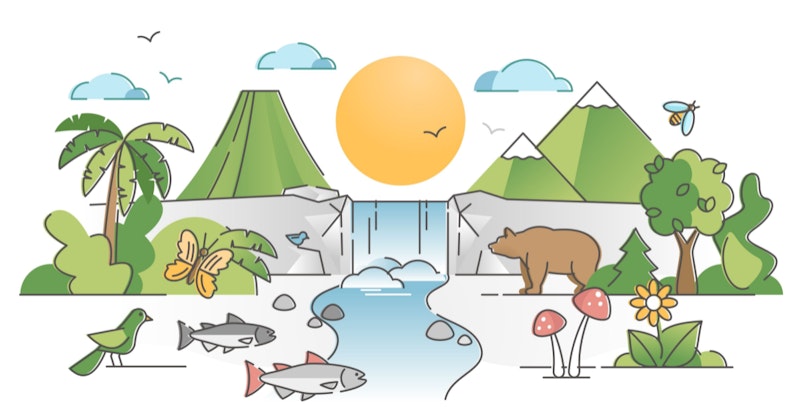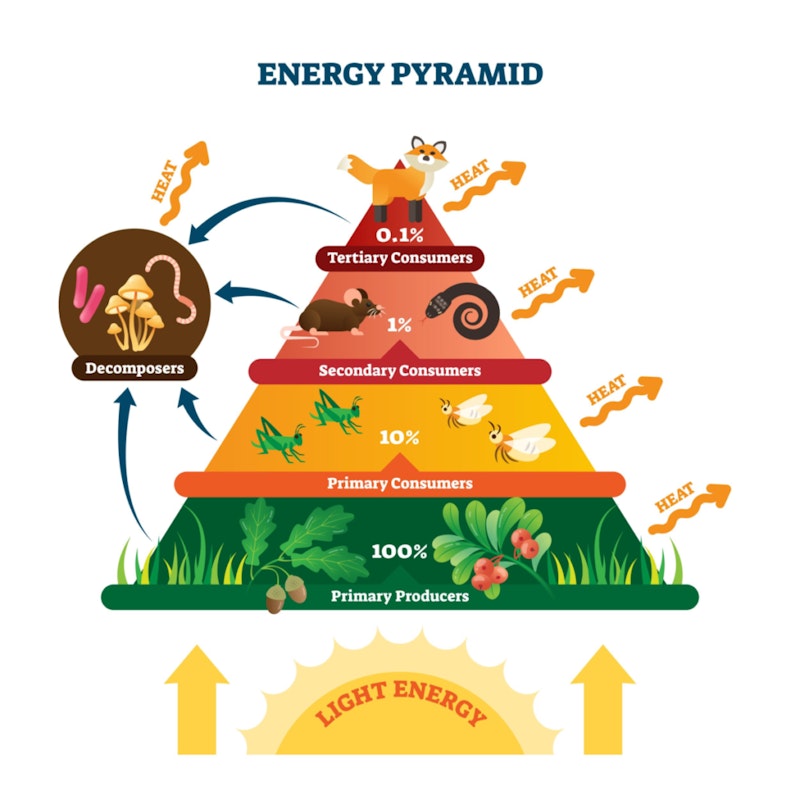Study Notes
GCSE Geography | What is an Ecosystem? (Ecosystems 1)
- Level:
- GCSE
- Board:
- AQA, Edexcel, OCR, Eduqas
Last updated 17 Oct 2024
An ecosystem is a natural system. It is the interaction of living (organic/biotic) and non-living (inorganic/abiotic) components.
Living/biotic components of an ecosystem
- Animals - including mammals, insects, birds and fish.
- Plants - trees, shrubs, grasses, mosses and algae - provide both food and shelter for many species of wildlife.
- Bacteria/fungi - these micro-organisms are decomposers, so they break down dead matter to release nutrients back into the soil, to be recycled.
Non-living/abiotic components of an ecosystem
- Air (oxygen/carbon dioxide) - oxygen needed for respiration; carbon dioxide needed in the process of photosynthesis.
- Sunlight - needed for photosynthesis and plant growth.
- Water - needed for plant growth and as a drinking source.
- Minerals (in rocks and soil) - rock type is important in the formation of soils - weathering releases nutrients from rocks into the soil; soils contain nutrients and water that are essential to plant growth, as well as providing a habitat for insects and decomposers.
Biotic and abiotic components are linked physically, such as animals eating plants, and chemically, for example acids in rainwater speeds up the process of decomposition.

Ecosystems can be a range of scales...
- Local/small-scale - sometimes referred to as a habitat.
- Regional - such as large areas of forest or moorlands (many of these form part of national parks).
- Global biomes - such as tropical rainforests along the equator, hot deserts or cold environments like the Tundra or Poles.
The nutrient cycle
Nutrients are foods that are used by plants or animals to grow.
There are two main sources of nutrients: rainwater washes chemicals out of the atmosphere, and weathered rock releases nutrients into the soil.
When plants or animals die, the decomposers help to recycle the nutrients making them available once again for the growth of plants or animals. Decayed material adds more nutrients to the soil, and these nutrients are then taken up by plant roots.

Key terms
Producers - convert energy from the environment (mainly sunlight) into sugars (glucose). The most obvious producers are plants that convert energy from the Sun by photosynthesis – to produce their own tissue (leaves, stems, etc) .
Photosynthesis - All ecosystems are fuelled by energy from the sun (solar energy) and without it they would not be able to work. This energy occurs in different forms: as heat, as light or stored as food energy in plants and the muscles of animals. Some organisms make their own food using energy from the sun. The ingredients are carbon dioxide, water and minerals and the process is called photosynthesis.
Consumers - get energy from the sugars produced by the producers. A pond snail is a good example of a consumer because it eats marine plants. There are different types of consumers in an ecosystem...
- Herbivores (or primary consumers) - only eat plants, eg. rabbits, cows
- Carnivores - only eat other animals (usually herbivores), eg. foxes
- Top carnivores - hunt and eat other carnivores, as well as herbivores - at the top of the food chain, eg. lions
- Omnivores - eat both animals and plants
Food chain - shows the transfer of energy in the form of food from organism to organism - the arrows show energy transfer.
Food web - shows the interdependent food chains in an ecosystem - enables you to see what would happen if you removed one aspect.

As you move up the food chain the amount of energy reduces - there are two reasons for this. Firstly, animals often don't eat a plant or another animals in its entirety, eg. animals don't eat the bones of other animals, and much of these energy will be lost through excretion. Secondly, energy is lost at each level as it is being used for important functions - such as respiration and digestion, however most is used simply trying to stay alive, for example searching for food and chasing prey (which can be exhausting and time-consuming for minimal reward).
You might also like
Ecosystem Succession
Study Notes
Palm Oil's threat to primates
14th August 2018
UN treaty to protect the World's oceans
4th September 2018
Daily Email Updates
Subscribe to our daily digest and get the day’s content delivered fresh to your inbox every morning at 7am.
Signup for emails